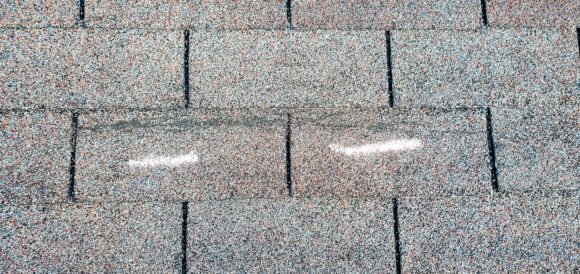A few years ago, in the early 2020s, it was not unusual to hear about or even see roofing workers in Florida deliberately manipulating roof shingles to make it appear that the roof was damaged by storm winds. I saw evidence of this as I inspected homes around the state and wrote engineering reports for insurance claims litigation.
From what I could see, this alleged practice declined in the last couple of years, maybe because insurance companies raised concerns about it, assignments of benefits were banned by the Florida Legislature, and thousands of homeowners had new roofs installed.
But now it seems to be on the rise again. Even on new roofs.
As a Florida engineer who regularly inspects structures and testifies in insurance lawsuits, I have seen several roofs this year that appear to have had asphalt shingles lifted – by hand – and creased or folded over. At one home, I counted 54 shingles that looked like this. The insurance claim said it must have come from wind, even though nearby wind measurements showed no more than 30 or 40 mph winds at the time of the supposed damage. And the roof was only four years old.
Which brings up some fundamental questions that insurance companies, their adjusters, expert witnesses and their attorneys should be thinking about: What, exactly, is a crease in a shingle? What caused it? Is there a “brittleness test” for shingles, as some engineers and roofers claim? And does a crease line in a shingle mean that the damage actually came from wind, or is it simply from age and normal wear and tear (or something mechanical, like a prybar)?
The answers depend on many factors, including the age of the shingles, how much they have weathered over the years, the type of shingle, and the pitch (or slope) of the roof. When someone claims to have performed a brittleness test, it also brings up questions about ethics. The primary reason this brittleness test does not exist in an official, approved manner is that not all shingles are constructed the same and temperatures can greatly affect the pliability of a shingle. The base materials also will result in different thickness of shingles and pliability.
 As a professional engineer, the only tests that I should be claiming to perform are those that are proven through a scientific method that has been approved by third parties. Without having an approved method, any claimed test is false. One test, some roofers have argued, is done by simply bending a shingle repeatedly until it cracks or that it makes an audible noise to indicating it is brittle. Conceivably, one could compare the pliability of a shingle with its manufacturer’s original testing data. But that would require special equipment and knowing the manufacturer and when the product was made.
As a professional engineer, the only tests that I should be claiming to perform are those that are proven through a scientific method that has been approved by third parties. Without having an approved method, any claimed test is false. One test, some roofers have argued, is done by simply bending a shingle repeatedly until it cracks or that it makes an audible noise to indicating it is brittle. Conceivably, one could compare the pliability of a shingle with its manufacturer’s original testing data. But that would require special equipment and knowing the manufacturer and when the product was made.
Second, the old-style three-tab shingles are more likely to crease from age and weathering. The newer, architectural or “dimensional” shingles are made of two laminated layers, giving the shingles extra strength and holding power. Studies done after Hurricane Frances found that only 44% of three-tab shingles had no damage while 87% of laminated shingles had no damage (T.P. Marshall, 2010).
Temperature is a primary factor that will cause a shingle to be pliable or stiff. The base material of shingles is tar and the colder the tar, the less fluid it is. The hotter it is outside, the more pliable a shingle is. Using the so-called “brittleness test,” roofers and engineers may claim that a shingle cannot be repaired. The claim is often false, as pliability of the shingle is temperature-dependent; a shingle that may appear brittle will be pliable with an increase in temperature. (Think: When the inspector or roofer lifted the shingles on a house to show that an insurance claim is in order, what was the temperature outside? And newer shingles are generally more pliable than older ones.)
So, a crease in a newer, laminated shingle can be suspicious. Isolated creasing in the middle of a roof also is suspect. Studies have shown that high winds tend to lift shingles more often near ridges, hips and along the roof perimeter.
Also, creasing does not mean catastrophic damage. If the roof granules are missing and a fold line can be seen on the surface, that does not prove that the shingle is compromised. Inspectors must gently lift the shingle and look on the underside: If the fiberglass mat is broken, then, yes, the shingle may need to be replaced.
A more tell-tale sign of actual windstorm damage can be seen where a row or rows of shingles have the granules worn away – not on a crease line but in a larger area.
While roof workers and some engineers may argue (far too often, from what I have seen) that a creased shingle indicates wind damage, insurers should be aware that a few missing granules on a crease line does not necessarily mean the integrity of the roof has been compromised. The wear line of a shingle must be carefully evaluated to determine the extent of damage and whether it is simply wear or actual damage to the mat or substrate.
The unfortunate truth is that it all comes down to ethics and morals. Some feel that making a living is more important than telling the truth about a roof. Manipulation of roof materials seems to have come into play more and more recently.
Professional engineers making false claims should be held accountable. As a professional engineer, I hold myself and others to a high standard. Stopping the unethical behavior will take effort from the courts and from the Florida Board of Professional Engineers. Florida Legislators should also give the board more teeth to help deter the unethical behavior of a few bad actors.
George Miles is an mechanical engineer with Alligator Consulting Engineers, in Edgewater, Florida. He has testified and has produced reports about wind damage on properties and has filed complaints against other engineers about allegedly specious arguments in insurance claims.
Was this article valuable?
Here are more articles you may enjoy.



 Insurance Industry ‘Megadeals’ Dominate 2025, Says PwC
Insurance Industry ‘Megadeals’ Dominate 2025, Says PwC  Icahn Money Manager Sues His Bosses and Bausch + Lomb Over Anti-White Bias
Icahn Money Manager Sues His Bosses and Bausch + Lomb Over Anti-White Bias  CEO Sentenced in Miami to 15 Years in One of the Largest Health Care Fraud Cases
CEO Sentenced in Miami to 15 Years in One of the Largest Health Care Fraud Cases  WTW to Acquire Newfront in Deal Worth Up to $1.3B
WTW to Acquire Newfront in Deal Worth Up to $1.3B 

